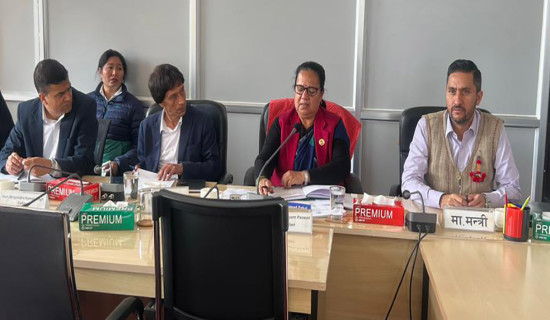- Wednesday, 3 December 2025
Make Your Home Poison Proof
Every year, thousands of unintentional poisonings occur during festival season in Nepal. During the Dashain festival, most schools remain closed and children under five years of age roam around their homes for 24 hours exploring new and unique things. Children are often curious and want to explore, dismantle, and taste everything they find in the vicinity. Common causes of poisoning in children are substances in daily use in most households.
Most often, poisoning in children occurs at ages below five years. At this age, children are adventurous and can walk, climb, and reach things they could not do it before. The most important poison prevention approach is to place medicines and chemicals out of reach and sight of children. A large majority of poisonings happen in the household. The majority of poisonings occur in the kitchen, bathroom, and bedroom. It is, therefore, important to follow simple steps in order to prevent such incidences at home.
Poison
Any substance that can cause harmful effects to the body is called a poison. Worldwide, millions of unintentional poisonings occur every year, and children under the age of five years are at the greatest risk. Unintentional poisonings seen in the emergency departments of the pediatric department occur mainly due to the ingestion of medications and household products, especially in the kitchen, living room, or bathroom.
Medicines account for most cases of poisoning in children. The medications most frequently involved in poisoning are drugs used by their parents and grandparents and range from drugs for diabetes to hypertension, psychiatric drugs, and paracetamol. Those medicines can be dangerous to children. Liquid medicines are often sweet and attractive in appearance, and a child getting hold of the bottle might consume a large amount in single ingestion making them sick.
A large majority of unintentional poisonings caused by household products are due to the ingestion of substances stored in non-original containers, although families admit that they stored these products within the reach of children. Kerosene stored in mineral water bottles and medicines in the non-child resistant container are examples and pose a great risk to children’s health.
Besides accidental consumption of toxic substances such as medicines and household chemicals, unintentional poisonings can also be caused by errors while giving medicines to children. The safe storage of toxic substances out of sight of children eliminates the risk of poisoning to a greater extent than direct parent supervision and constitutes an efficient method of preventing poisoning accidents.
There are numerous chemical products found in the home that are potentially hazardous such as medications, bathroom cleaners, sprays, perfumes, hair sprays, and mouthwashes. Household products such as cleaners, polishers, solvents, and products containing bleach and acid also pose danger to the children if ingested. Insecticides, kerosene, turpentine, paint, glue, batteries and kitchen detergents, bleach, softeners, and pet products are also among the chemicals involved in unintentional poisoning. Besides those chemicals, indoor plants and sometimes outdoor plants and wild-grown mushrooms in the garden can cause poisoning to children. Plants enhance the beauty of homes and gardens, but some are dangerous. They can make the children poisoned if eaten.
Prevention
It is recommended to all parents to read all labels and follow directions before using any product. Storing all poisonous substances out of the reach of children; in locked cabinets or in cabinets secured with safety locks is the key to preventing poisoning. Also important is to store all potentially poisonous substances in their original containers and never store poisonous substances in old food containers such as mineral water bottles.
It is suggested to always buy and use child-resistant packaging but it is to be noted that children can and do open these containers. Oftentimes, we call medicine candy to children, and this simple mistake may lead to poisoning in absence of caretakers. Equally important is not to take medicine in front of children or allow them to play with medicine containers as they are experts in mimicking the act of adults. We should teach children not to touch or eat anything they do not recognise. It is recommended not to leave children alone with household products or drugs. It is, therefore, advised to use bathroom cleaners, drain cleaners, and other hazardous chemicals when children are away.
If you suspect that a poisoning has occurred, call the poison information centre. Remaining calm and providing information about the condition, age, and weight of the patient; and product container or bottle that caused the poisoning; and the time that the poisoning occurred are vital in managing unintentional poisoning. Oftentimes, the ingested substances may be non-poisonous such as silica gel or mercury from a thermometer, and many other chemicals in a small dose and is not necessary to take them to the hospital.
In a large majority of cases, parents try to make children vomit in poisoning emergencies which are dangerous and cause more harm than good. Thus, it is recommended to follow the instructions given by the experts from the poison center. The take-home message is that we can make our home poison-proof with simple steps which is particularly important during festival seasons.
(Dr. Lohani is the clinical director at the Nepal Drug and Poison Information Centre. lohanis@gmail.com)

















